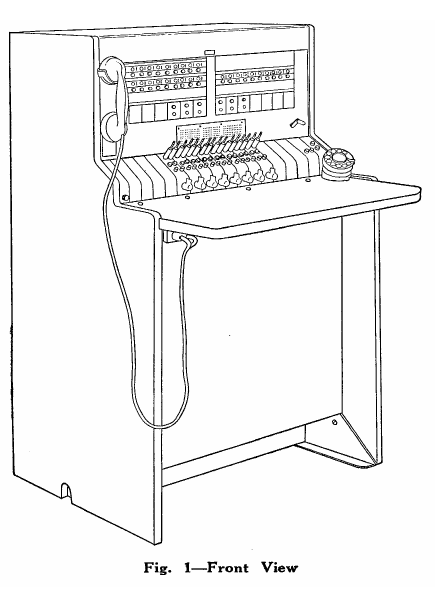Ever wonder — How did call centers get their start? What is the history of call center technology? This article digs into the origin story of call center ACDs.
Electronic Switching Systems
Call centers started out using private branch exchanges (“PBX’s”) — switchboards that could be located near extension stations or phones. These systems provided a number of features, including the ability to bridge calls together into conference calls as well as to route certain calls to specific extensions or groups. As shown in the image above, these early PBX’s were not small devices. The No. 555 PBX offered by AT&T in 1958 (shown in the image) was 4 feet tall, 2.5 feet wide, and 2.5 feet deep and provided connections for up to 120 extension lines. In the event of a power outage, the No. 555 PBX offered a hand generator for emergency ringing.
These early PBX’s were a step forward in that they provided electronic switching and routing of calls. Previous switchboards required operators to manually plug in connections to bridge or route calls. The No. 555 PBX used electronic circuits to perform this switching and allowed different locations to interconnect remote PBX’s together.

Changes in U.S. Dialing Patterns give birth to TSPS Positions
Dialing patterns evolved in the United States In the 1960’s. Toll-free numbers were introduced. More importantly, the 60’s saw the introduction of touch-tone phones after Bell Labs came up with dual-tone multi-frequency (DTMF) dialing (beginning the replacement of rotary phones). Bell Lab’s parent company, AT&T, filed a trademark application for “TOUCH-TONE” in 1960. The ability to send unique tones through the telephone networks was revolutionary, and made possible many modern-day call center conveniences (including interactive voice response units, secure telephone payments, etc).
During this time period, the number of operator assisted calls grew dramatically. To reduce the number of operator assisted calls, Bell Laboratories developed a dial pattern where a caller who wanted operator assistance would dial “0” and then the intended number. The “0” would cause the call to be routed to a Traffic Service Position System (“TSPS”) operator. These TSPS operators used PBX systems that switched calls electronically, often using early semi-conductor technology. A TSPS operator recruiting video from AT&T in 1974 is shown below.
Telephone Switching Gets Supercharged with Semi-Conductors
At this point, PBX's are used to route calls to different destinations. TSPS operators are actually working in the OG call centers. The next big boost is the invention of semi-conductor technologies which turbo charges the technology that can be packed into PBX systems. In 1975, Bell Labs releases the “DIMENSION PBX” an innovative and “all-electronic customer switching system”. (You can read more about the DIMENSION PBX here). The new age of call center software was birthed with this device.
ACDs now become common
With the launch of the DIMENSION PBX, innovation spread quickly. Bell Labs and AT&T continued to innovate in call center technologies, and ACDs became standard in their offerings.
An example of one of their ACD offerings is described in the “Basic ACD Service Feature” specification available here. Here's how Bell Labs described the ACD Service Feature:
The basic automatic call distribution (basic ACD) service feature provides
automatic routing of incoming traffic to business customer agents to insure a uniform loading of the agents. Basic ACD service uses standard telephone sets and/or key telephone sets for agent position equipment.
Sounds like a present-day definition of an ACD, right? This definition from Bell Labs is from a 1978 Manual.
Here's more from that Manual:
The features of basic ACD service are grouped in five major functional categories: incoming call features, agent position features, supervisor position features, system features, and management information features.
Since 1978, the features of a basic ACD have not changed much!

